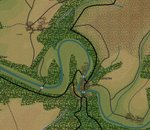These separate tasks were fairly straightforward, and doing it is all explained quite well in the manual. That doesn't mean I didn't do some of them twice though, learning the hard way a couple of times.
One of the challenges in creating the map and the scenario was recreating an amphibious crossing. I first considered it a problem that might have a map-based solution, and I tried to think of a way to do it using a ferry crossing. Or, thinking I might be clever, using the "lake" terrain element, and actually giving it "movement" points that would allow forces to cross over it as if it were land. I tried this and it did not work. And, it's good that it did not work because this would be a part of the terrain that would work equally well for either side. Further, the AI would use this as a way to move non-amphib equipped troops across the river. In the end, I decided to handle the amphib crossing of six companies as a reinforcement in the scenario that simply appears on the map across the river at the appointed time. More on this when I write about creating units and building the scenario.
Another fun challenge was creating St. Lo. The map maker includes a "city" terrain tile, and I drew a St. Lo sized shape on the map and thought I would be done. As I looked at the final drawing, however, it did not have the same feel that the cities in the game. It lacked a personality that made it feel more realistic, and more engrossing. So, I worked on it for quite a while, trying to capture the feel of an older town. St. Lo is the ancient seat of the district, and should have some intricacies to it. I thumbed through "Great Streets" which has several great overhead drawings of old European cites to show how their streets influenced their design and how they had an organic feeling.
I created the following city layout, which has some interest to it, but is still not close to the quality of those provided with the game.

I think creating maps is easy to do mechanically, although getting the maps to look as detailed as those in the game takes work. I'd say it's worth buying any future installment of the game for the maps alone. The maps in the game are extremely detailed with patches of woods or light woods in irregular shapes, and mixtures of urban and other terrain elements. In general, they look interesting, the way topography does.
Studying the game maps gives you ideas about your creating your own map, but you'll need to use your imagination at times, even if you can find maps like the one shown in this post. In the end, my map includes some fiction to give it a less "sterile" look.
My map also benefits greatly from the Hedgerow terrain mod itself. It blankets a large part of the map and gives it the kind of detail that it would otherwise lack.
I followed the instructions for creating the map files, which is a purely automatic process, and was excited to get some forces on it and try it out.

No comments:
Post a Comment